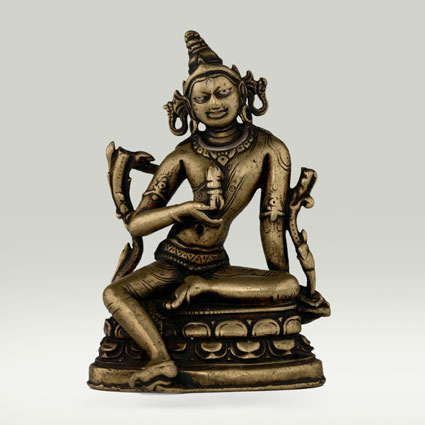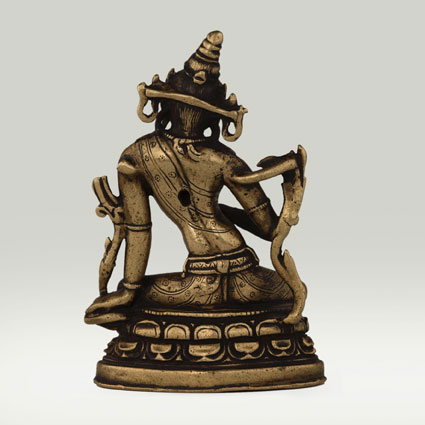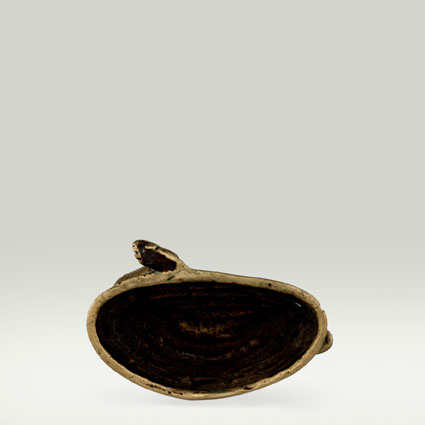ABS 067
Code: ABS 067
Country: India (north-east)
Style: Late Pala Style
Date: 1000 - 1100
Dimensions in cm WxHxD: 5.1 x 7.5 x 3.3
Materials: Brass
Hollow cast in one piece.
The eyes, urna and necklace are inlaid with "silver" and the lips with copper.
The garment and ornaments are decorated with engraved linear and zigzag patterns and clusters of dots.
The bottom of the image is not sealed.
Vajrapani (Tib. Phyag na rdo rje) is seated in the attitude of ease( lalitasana) on a double lotus pedestal with beaded borders, and rests the right foot on a lotus flower (padma). He holds with the right hand a five-pronged diamond sceptre (vajra) in front of the chest and leans on the left hand which holds the stalk of a broken lily (utpala) originally blossoming at the shoulder level. Another broken lotus is growing of from the other side of the pedestal. Vajrapani is clad with a cloth tied around the waist and fastened with a beaded belt and wears a shawl over the left shoulder and tied across the chest. He wears princely ornaments, namely a tiny three-pointed crown in front of the tall knot of hair with a jewelled tip, a pair of circular earrings, a beaded necklace with attached pendants, and ornaments on both upper arms, wrists and feet.
In this publication the following forms of Vajrapani are distinguished: Bodhisattva Vajrapani (Tib. Phyag na rdo rje) in the bodhisattva attitude; Candavajrapani (Tib. Phyag rdor gtum po), a wrathful form with vajra and tarjani mudra; Nilambaradhara Vajrapani (Tib. Phyag rdor gos sngon can), a wrathful form with vajra and ghanta attributes; Sri Ucarya Vajrapani (Tib. Phyag rdor u tsa rya), a wrathful form with vajra and ghanta attributes, and garuda (Tib. Khyung) emblems; Mahacakra Vajrapani (Tib. ’Khor lo chen po), a six-armed and three-headed wrathful form with vajra and ghanta attributes, and naga emblems. This division does not take into account all the numerous Tibetan forms with other names.
Vajrapani (from Sanskrit vajra, "thunderbolt" or "diamond" and pani, lit. "in the hand") is one of the earliest bodhisattvas of Mahayana Buddhism. He is the protector and guide of the Buddha and rose to symbolize the Buddha's power. Vajrapani was used extensively in Buddhist iconography as one of the three protective deities surrounding the Buddha. Each of them symbolizes one of the Buddha's virtues: Manjusri (the manifestation of all the Buddhas' wisdom), Avalokitesvara (the manifestation of all the Buddhas' compassion) and Vajrapani (the manifestation of all the Buddhas' power)
Names
In Sanskrit, Vajrapani is known as Vajrapanina bodhisattvena mahasattvena, vajra-sattvaand, in Tibetan, as Lag na Rdo rje (Chana Dorji).
On the popular level, Vajrapani, Holder of the Thunderbolt Scepter (symbolizing the power of compassion), is the Bodhisattva who represents the power of all the Buddhas, just as Avalokitesvara represents their great compassion, Manjusri their wisdom, and Tara their miraculous deeds. For the yogi, Vajrapani is a means of accomplishing fierce determination and symbolizes unrelenting effectiveness in the conquest of negativity. His taut posture is the active warrior pose (pratayalidha), based on an archer's stance but resembling the en gardeposition in Western fencing. His outstretched right hand brandishes a vajra and his left hand deftly holds a lasso – with which he binds demons. He wears a skull crown with his hair standing on end. His expression is wrathful, and he has a third eye. Around his neck is a serpent necklace and his loin cloth is made up of the skin of a tiger, whose head can be seen on his right knee.
Iconography
The first representations of Vajrapani in India associated him with the Hindu God Indra. As Buddhism expanded in Central Asia, and fused with Hellenistic influences into Greco-Buddhism, the Greek hero Hercules was adopted to represent Vajrapani. He was then typically depicted as a hairy, muscular athlete, wielding a short "diamond" club. Mahayana Buddhism then further spread to China, Korea and Japan from the 6th century.
In Japan, Vajrapani is known as Shukongōshin ("Diamond rod-wielding God"), and has been the inspiration for the Nio (lit. Benevolent kings), the wrath-filled and muscular guardian god of the Buddha, standing today at the entrance of many Buddhist temples under the appearance of frightening wrestler-like statues.
"The origin of the image of Vajrapani should be explained. This deity is the protector and guide of the Buddha Shakyamuni. His image was modelled after that of Hercules. (...) The Gandharan Vajrapani was transformed in Central Asia and China and afterwards transmitted to Japan, where it exerted stylistic influences on the wrestler-like statues of the Guardian Deities (Nio)." (Katsumi Tanabe, "Alexander the Great, East-West cultural contacts from Greece to Japan", p23).
Bhattacharyya, Benoytosh , 1958. Indian Buddhist Iconography. Calcutta: K. L. Mukhopadhyay. Pp. 43, 53, 98–99, 131 - References to the iconography of Vajrapani
de Mallmann, Marie-Thérèse, 1975. Introduction à l'iconographie du tântrisme bouddhique. Paris: Adrien Mainsonneuve (Jean Maisonneuve successeur (1970). Pp. 413-415 - References to the iconography of Vajrapani
Sèngué, Tcheuky, 2002. Petite Encyclopédie des Divinités et symboles du Bouddhisme Tibétain. Editions Claire Lumiere . Pp. 163 / 192-196






